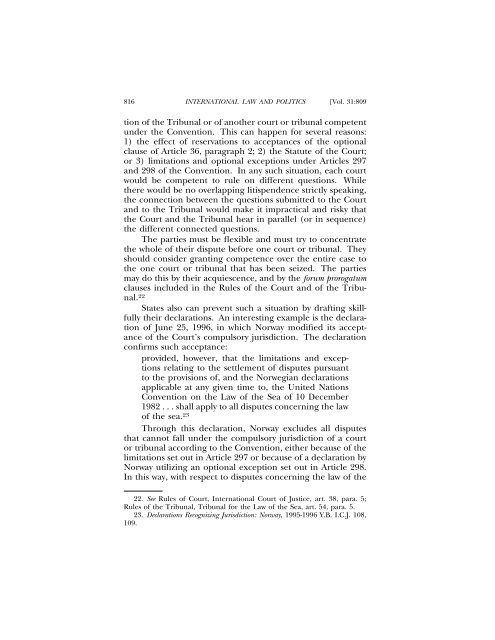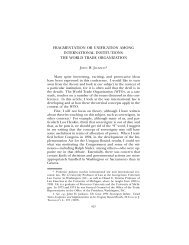Tullio Treves, Conflicts Between the International Tribunal for the ...
Tullio Treves, Conflicts Between the International Tribunal for the ...
Tullio Treves, Conflicts Between the International Tribunal for the ...
Create successful ePaper yourself
Turn your PDF publications into a flip-book with our unique Google optimized e-Paper software.
816 INTERNATIONAL LAW AND POLITICS [Vol. 31:809tion of <strong>the</strong> <strong>Tribunal</strong> or of ano<strong>the</strong>r court or tribunal competentunder <strong>the</strong> Convention. This can happen <strong>for</strong> several reasons:1) <strong>the</strong> effect of reservations to acceptances of <strong>the</strong> optionalclause of Article 36, paragraph 2; 2) <strong>the</strong> Statute of <strong>the</strong> Court;or 3) limitations and optional exceptions under Articles 297and 298 of <strong>the</strong> Convention. In any such situation, each courtwould be competent to rule on different questions. While<strong>the</strong>re would be no overlapping litispendence strictly speaking,<strong>the</strong> connection between <strong>the</strong> questions submitted to <strong>the</strong> Courtand to <strong>the</strong> <strong>Tribunal</strong> would make it impractical and risky that<strong>the</strong> Court and <strong>the</strong> <strong>Tribunal</strong> hear in parallel (or in sequence)<strong>the</strong> different connected questions.The parties must be flexible and must try to concentrate<strong>the</strong> whole of <strong>the</strong>ir dispute be<strong>for</strong>e one court or tribunal. Theyshould consider granting competence over <strong>the</strong> entire case to<strong>the</strong> one court or tribunal that has been seized. The partiesmay do this by <strong>the</strong>ir acquiescence, and by <strong>the</strong> <strong>for</strong>um prorogatumclauses included in <strong>the</strong> Rules of <strong>the</strong> Court and of <strong>the</strong> <strong>Tribunal</strong>.22 States also can prevent such a situation by drafting skillfully<strong>the</strong>ir declarations. An interesting example is <strong>the</strong> declarationof June 25, 1996, in which Norway modified its acceptanceof <strong>the</strong> Court’s compulsory jurisdiction. The declarationconfirms such acceptance:provided, however, that <strong>the</strong> limitations and exceptionsrelating to <strong>the</strong> settlement of disputes pursuantto <strong>the</strong> provisions of, and <strong>the</strong> Norwegian declarationsapplicable at any given time to, <strong>the</strong> United NationsConvention on <strong>the</strong> Law of <strong>the</strong> Sea of 10 December1982 . . . shall apply to all disputes concerning <strong>the</strong> lawof <strong>the</strong> sea. 23Through this declaration, Norway excludes all disputesthat cannot fall under <strong>the</strong> compulsory jurisdiction of a courtor tribunal according to <strong>the</strong> Convention, ei<strong>the</strong>r because of <strong>the</strong>limitations set out in Article 297 or because of a declaration byNorway utilizing an optional exception set out in Article 298.In this way, with respect to disputes concerning <strong>the</strong> law of <strong>the</strong>22. See Rules of Court, <strong>International</strong> Court of Justice, art. 38, para. 5;Rules of <strong>the</strong> <strong>Tribunal</strong>, <strong>Tribunal</strong> <strong>for</strong> <strong>the</strong> Law of <strong>the</strong> Sea, art. 54, para. 5.23. Declarations Recognizing Jurisdiction: Norway, 1995-1996 Y.B. I.C.J. 108,109.






